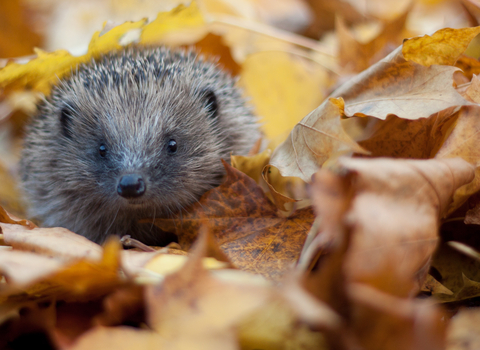
Hedgehog © Jon Hawkins - Surrey Hills Photography
European hedgehog
Scientific name
Erinaceus europaeusWhen to see
April to OctoberSpecies information
Category
Statistics
Length: 15-30cmTail: 1-2cm
Weight: up to 2kg
Average lifespan: 2-3 years
IUCN Red List for British Mammals - vulnerable to extinction.
About
Round, brown and famously covered in spines, the hedgehog is the UK’s most familiar wild animal. They can be spotted in parks and gardens where bushes provide the perfect daytime getaway! They love long grass full of insects to feast on once the sun has set.Hedgehogs eat all kinds of invertebrates, as well as amphibians, birds' eggs and anything else they can catch; they particularly like big, crunchy beetles and earthworms, making them a gardener's best friend. Hedgehogs hibernate over winter, from about November to April, in a nest of leaves or logs called a 'hibernaculum'.
How to identify
A unique and unmistakeable animal, the hedgehog is small, brown and round, with yellow-tipped spines over its back, and a fur-covered face. Mostly nocturnal, you may see or hear one snuffling around the garden. Or look out for the signs of hedgehogs, such as medium-sized, black droppings full of insect bits on the lawn.Distribution
Widespread, found throughout the country in a variety of habitats, though absent from some Scottish Islands. A large proportion of the hedgehogs on Alderney are blonde!In our area
Hedgehogs were once common across Shropshire, but the population has declined by over 75% over the last 50 years. Their decline is attributed to a number of factors, including changing agricultural practice, use of lethal slug pellets and climate change. Hedgehogs can forage for food over a large distance and are often killed as they cross roads at night. because they move around so much, man-made barriers, such as concrete-based garden fences can greatly impact a hog's ability to travel in search of food and could be another factor in their decline in some areas.
The most likely places to see hedgehogs are now in parks and gardens rather than open countryside. We can all do our bit to help hedgehogs in our local area, including our gardens. Click on the links below to find out how you can help.
Did you know?
Hedgehogs are known for their ability to roll themselves into a ball of spines when threatened. These spines are actually modified hairs and the average hedgehog has about 7000 of them, which can be raised using powerful muscles along their back.Watch
Hedgehog (https://vimeo.com/473378502)
Hedgehog by Stuart Edmunds
Hedgehogs were once common across Shropshire, but the population has declined by over 75% over the last 50 years. Their decline is attributed to a number of factors, including changing agricultural practice, use of lethal slug pellets and climate change. Hedgehogs can forage for food over a large distance and are often killed as they cross roads at night. because they move around so much, man-made barriers, such as concrete-based garden fences can greatly impact a hog's ability to travel in search of food and could be another factor in their decline in some areas.
The most likely places to see hedgehogs are now in parks and gardens rather than open countryside. We can all do our bit to help hedgehogs in our local area, including our gardens. Click on the links below to find out how you can help.

